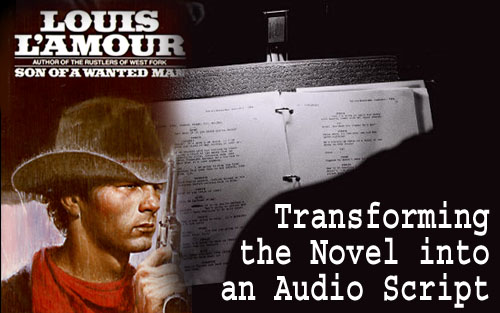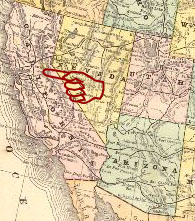|

There are quite a few changes
that were made in the process of adapting the novel "Son
of a Wanted Man" into an audio play. The first alterations
were made in the transition from novel to screenplay, although
they were changes that would be considered for any dramatic
form (film, theater, or audio).
In conventional drama the audience
is outside the story, voyeuristically watching it unfold;
the only things they know about the plot or the characters
is what they see or hear. The only way they know what the
characters think or feel is by watching what they do, the
actions they take, the reactions they have. Since the story
follows Mike, I thought it was appropriate for him to go
away from Ben for awhile. That way, when he returns, the
audience can learn about the conditions at Robber’s Roost
as he does. It also gave him a chance to get away and become
independent from Ben, develop a normal set of ethics, and
give up on the idea of joining the outlaw gang.
The episodes where Ben kills Dan
Peeples and Mike’s being “adopted” by Ben were related to
one another for efficiency’s sake. Mike Bastian becoming
Miguel Santos was done for casting purposes but it really
helped Mike/Miguel realize that he had been born into a
different life than the one Ben Curry has made for him.
 The
original story had been set in Utah and Arizona but when thinking about getting it produced as a film we realized
that no reasonable amount of money was going to allow it
to be shot anywhere in the Southwest. Movie locations, especially
those appropriate for more moderately priced films can not
be too far apart. Traveling long distances to and from the
set and moving the whole company a couple hundred miles
from one location to another is a waste of precious time,
and time is money. You simply have to find all your locations
within less than an hour's drive of one another and preferably
much less than that. Nowhere in the Southwest was there
a good looking ranch, a western town, a train, and a picturesque
hideout location all within a sixty mile radius. On top
of it we started to realize that, in reality, our fictional
outlaws would have the same problem … if we had to establish
them riding for a week between the town and the hideout,
several days to get to the ranch, or a couple of weeks out
to the rail-yard where Mike is found when he first appears
as an adult, it would really take the tension out of any
story portrayed as drama. The
original story had been set in Utah and Arizona but when thinking about getting it produced as a film we realized
that no reasonable amount of money was going to allow it
to be shot anywhere in the Southwest. Movie locations, especially
those appropriate for more moderately priced films can not
be too far apart. Traveling long distances to and from the
set and moving the whole company a couple hundred miles
from one location to another is a waste of precious time,
and time is money. You simply have to find all your locations
within less than an hour's drive of one another and preferably
much less than that. Nowhere in the Southwest was there
a good looking ranch, a western town, a train, and a picturesque
hideout location all within a sixty mile radius. On top
of it we started to realize that, in reality, our fictional
outlaws would have the same problem … if we had to establish
them riding for a week between the town and the hideout,
several days to get to the ranch, or a couple of weeks out
to the rail-yard where Mike is found when he first appears
as an adult, it would really take the tension out of any
story portrayed as drama.
The answer was the California
Gold Country. To make matters better, I had already worked
there on The Shadow Riders (and would work there again on
the CBS pilot, Shaughnessy). We knew the people, the locations,
everything. Whern I started writing the script, I tried to use every interesting place we had visited; many of which
we had never been able to use in those earlier productions.
Knights Ferry became the location for Brandt's Bridge (Sam
Brandt was a pseudonym that Dad wrote under briefly), Columbia,
California became the set for the fictional town of Brandt's
Crossing, and a recreation spot called Kennedy Meadows was
the perfect place to build the outlaw hideout. We found
the ranch where Ben Curry's daughters could live when we
went to pick up the woman who worked for the Toulumne County Film Commission … she lived at a place that had been
built by shipwrights from San Francisco in the 1850s ...
an isolated ranch not too far from the town of Sonora. The
cemetery would have been shot at the church in Chinese Camp
and the Oregon railroad yard was in nearby Jamestown. Many
of the Sierra countryside shots could easily have been shot
in the real Sierra countryside.
|
|
|
|
|
|
Brandt's
Bridge
|
Brandt's
Crossing
|
Brandt's
Crossing
|
Robber's
Roost
|
|
|
|
|
|
|
|
R-Bar
Ranch
|
Cemetary
|
Train
Roundhouse
|
Sierra
Vista
|
One of the problems with drama
is that while a picture is worth a thousand words, playing
out a scene takes much longer than reading a scene in a
novel. Son of a Wanted Man is over two hours but if you
remove the Narrator telling you what you are seeing it ends
up being just a bit long for a film, remove the scenes that
form the “bookends” to the story and it comes in just under
two hours. Of course this left no time at all for the sub
plot regarding Borden Chantry and Tyrel Sackett but it’s
not their story. All the growth, the character evolution,
occurs within Ben’s somewhat dysfunctional family. The first
rule of adapting drama is that you must focus … it’s why
a film or play is actually closer in form to a short story
than a novel. Anyway, the only point that the Chantry/Sackett
sub plot made in the story as a whole was that Ben’s days
were numbered. That point was more easily touched on in
other ways like the “bookends” that carry Ben from a romantic
and adventurous youth through to his death many years later.
I realized I needed
to improve Mike's dilemma over whether to not to take up
Ben's offer of the outlaw gang. So, I added a scene with
Young Mike asking when he can be a part of the gang. We
needed some more romantic suggestions between Mike and Drucilla
and scenes that connected Mike to his actual background
and his real father. So a couple of scenes in town where
Mike deals with Drucilla and his own childhood memories
were created. I rewrote pieces of a number of other scenes
to bring more focus to the themes and the characters. Then
I read a bunch of old books to find a "style"
for the narrator that had a hint of nineteenth century writing
and added the first scene, the two men on the dock, as an
introduction and to give some Gold Rush context. One day,
while absorbed in trying to make all the narration work
around the various scenes, I came up with the last piece
of the puzzle.
"I
used to call myself a Gentleman of Opportunity!"
I was taking a break and I walked
down to the local Mexican restaurant. Somewhere along the
way, I suddenly thought of the line of dialogue where Ben
says: "I used to call myself a Gentleman of Opportunity
… well I'm no Gentleman and, by God, this is not
an Opportunity!" By the time I got home this had turned
into a theme that resolved the story taking Ben Curry from
a period of his life where he imagines himself to be a dashing
young outlaw to the point where he is an old man. I used
a trick that my Dad had loved to resolve the story, bringing
it up through history into the twentieth century (see the
end of Dark
Canyon or The
Highgraders). The same day I discovered another whole
theme that revolved around the outlaws as cases of arrested
development … boys that never grew up. I went back and tried
to subtly rewrite both Ben and Perrin to reflect this and
it clarified some of what I was doing with Mike; the question
of his character was if he was going to "grow up"
or not.
I have always thought that it’s
more important to capture the mood or tone of the original
work in an adaptation than trying to literally reproduce
the novel, short story, or whatever the underlying material
was. It has seemed that the only times that people complain
about a movie, play, or audio not being identical to the
original is when they don’t like it … thus suggesting that
quality is a fair replacement for literal accuracy. In the
end it is truly impossible to duplicate a printed work on
the stage or screen because the mediums are just so different.
Drama is very literal; you do not imagine how the characters
interact, you see it or hear it. Fiction relies totally
on the imagination of the audience. When you read a book,
you cast the characters, you construct the locations, and
you play all the parts … it is an amazing partnership between
artist and audience. However, it is a partnership that is
immediately dissolved when a director, actors, and editing
are added to the mixture. From then on it is merely the
outcome of what the production struggled to create in whatever
technically limited medium they chose.
And, as my Dad always said:
“They
didn’t change my book … they just made a movie out
of it.”
You can get the novel
from the Trading
Post
and you can download a PDF of the script HERE
|
